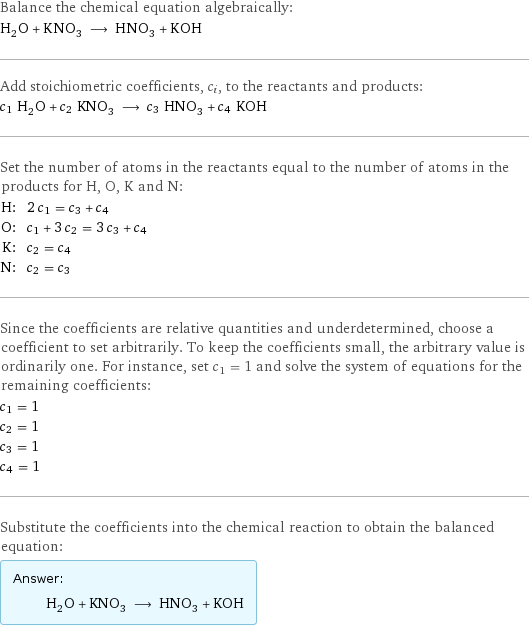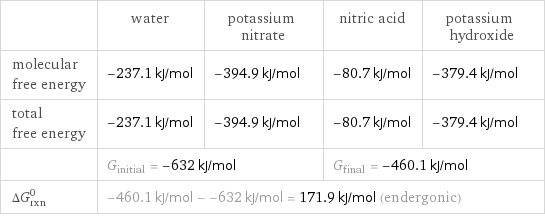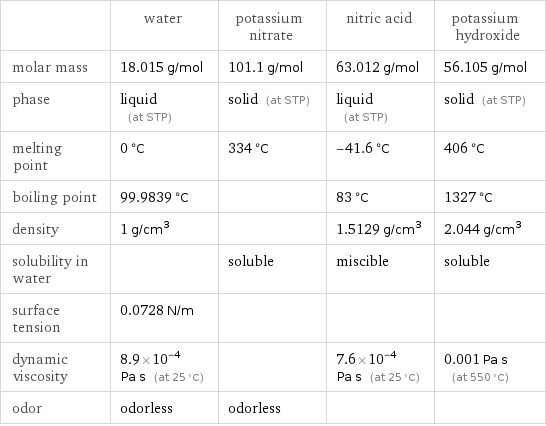Input interpretation

H_2O water + KNO_3 potassium nitrate ⟶ HNO_3 nitric acid + KOH potassium hydroxide
Balanced equation

Balance the chemical equation algebraically: H_2O + KNO_3 ⟶ HNO_3 + KOH Add stoichiometric coefficients, c_i, to the reactants and products: c_1 H_2O + c_2 KNO_3 ⟶ c_3 HNO_3 + c_4 KOH Set the number of atoms in the reactants equal to the number of atoms in the products for H, O, K and N: H: | 2 c_1 = c_3 + c_4 O: | c_1 + 3 c_2 = 3 c_3 + c_4 K: | c_2 = c_4 N: | c_2 = c_3 Since the coefficients are relative quantities and underdetermined, choose a coefficient to set arbitrarily. To keep the coefficients small, the arbitrary value is ordinarily one. For instance, set c_1 = 1 and solve the system of equations for the remaining coefficients: c_1 = 1 c_2 = 1 c_3 = 1 c_4 = 1 Substitute the coefficients into the chemical reaction to obtain the balanced equation: Answer: | | H_2O + KNO_3 ⟶ HNO_3 + KOH
Structures

+ ⟶ +
Names

water + potassium nitrate ⟶ nitric acid + potassium hydroxide
Reaction thermodynamics
Gibbs free energy

| water | potassium nitrate | nitric acid | potassium hydroxide molecular free energy | -237.1 kJ/mol | -394.9 kJ/mol | -80.7 kJ/mol | -379.4 kJ/mol total free energy | -237.1 kJ/mol | -394.9 kJ/mol | -80.7 kJ/mol | -379.4 kJ/mol | G_initial = -632 kJ/mol | | G_final = -460.1 kJ/mol | ΔG_rxn^0 | -460.1 kJ/mol - -632 kJ/mol = 171.9 kJ/mol (endergonic) | | |
Equilibrium constant
![Construct the equilibrium constant, K, expression for: H_2O + KNO_3 ⟶ HNO_3 + KOH Plan: • Balance the chemical equation. • Determine the stoichiometric numbers. • Assemble the activity expression for each chemical species. • Use the activity expressions to build the equilibrium constant expression. Write the balanced chemical equation: H_2O + KNO_3 ⟶ HNO_3 + KOH Assign stoichiometric numbers, ν_i, using the stoichiometric coefficients, c_i, from the balanced chemical equation in the following manner: ν_i = -c_i for reactants and ν_i = c_i for products: chemical species | c_i | ν_i H_2O | 1 | -1 KNO_3 | 1 | -1 HNO_3 | 1 | 1 KOH | 1 | 1 Assemble the activity expressions accounting for the state of matter and ν_i: chemical species | c_i | ν_i | activity expression H_2O | 1 | -1 | ([H2O])^(-1) KNO_3 | 1 | -1 | ([KNO3])^(-1) HNO_3 | 1 | 1 | [HNO3] KOH | 1 | 1 | [KOH] The equilibrium constant symbol in the concentration basis is: K_c Mulitply the activity expressions to arrive at the K_c expression: Answer: | | K_c = ([H2O])^(-1) ([KNO3])^(-1) [HNO3] [KOH] = ([HNO3] [KOH])/([H2O] [KNO3])](../image_source/0771090535b06970a10ba057b9af36b7.png)
Construct the equilibrium constant, K, expression for: H_2O + KNO_3 ⟶ HNO_3 + KOH Plan: • Balance the chemical equation. • Determine the stoichiometric numbers. • Assemble the activity expression for each chemical species. • Use the activity expressions to build the equilibrium constant expression. Write the balanced chemical equation: H_2O + KNO_3 ⟶ HNO_3 + KOH Assign stoichiometric numbers, ν_i, using the stoichiometric coefficients, c_i, from the balanced chemical equation in the following manner: ν_i = -c_i for reactants and ν_i = c_i for products: chemical species | c_i | ν_i H_2O | 1 | -1 KNO_3 | 1 | -1 HNO_3 | 1 | 1 KOH | 1 | 1 Assemble the activity expressions accounting for the state of matter and ν_i: chemical species | c_i | ν_i | activity expression H_2O | 1 | -1 | ([H2O])^(-1) KNO_3 | 1 | -1 | ([KNO3])^(-1) HNO_3 | 1 | 1 | [HNO3] KOH | 1 | 1 | [KOH] The equilibrium constant symbol in the concentration basis is: K_c Mulitply the activity expressions to arrive at the K_c expression: Answer: | | K_c = ([H2O])^(-1) ([KNO3])^(-1) [HNO3] [KOH] = ([HNO3] [KOH])/([H2O] [KNO3])
Rate of reaction
![Construct the rate of reaction expression for: H_2O + KNO_3 ⟶ HNO_3 + KOH Plan: • Balance the chemical equation. • Determine the stoichiometric numbers. • Assemble the rate term for each chemical species. • Write the rate of reaction expression. Write the balanced chemical equation: H_2O + KNO_3 ⟶ HNO_3 + KOH Assign stoichiometric numbers, ν_i, using the stoichiometric coefficients, c_i, from the balanced chemical equation in the following manner: ν_i = -c_i for reactants and ν_i = c_i for products: chemical species | c_i | ν_i H_2O | 1 | -1 KNO_3 | 1 | -1 HNO_3 | 1 | 1 KOH | 1 | 1 The rate term for each chemical species, B_i, is 1/ν_i(Δ[B_i])/(Δt) where [B_i] is the amount concentration and t is time: chemical species | c_i | ν_i | rate term H_2O | 1 | -1 | -(Δ[H2O])/(Δt) KNO_3 | 1 | -1 | -(Δ[KNO3])/(Δt) HNO_3 | 1 | 1 | (Δ[HNO3])/(Δt) KOH | 1 | 1 | (Δ[KOH])/(Δt) (for infinitesimal rate of change, replace Δ with d) Set the rate terms equal to each other to arrive at the rate expression: Answer: | | rate = -(Δ[H2O])/(Δt) = -(Δ[KNO3])/(Δt) = (Δ[HNO3])/(Δt) = (Δ[KOH])/(Δt) (assuming constant volume and no accumulation of intermediates or side products)](../image_source/f1468ef4c799e0446573da6be9f2f626.png)
Construct the rate of reaction expression for: H_2O + KNO_3 ⟶ HNO_3 + KOH Plan: • Balance the chemical equation. • Determine the stoichiometric numbers. • Assemble the rate term for each chemical species. • Write the rate of reaction expression. Write the balanced chemical equation: H_2O + KNO_3 ⟶ HNO_3 + KOH Assign stoichiometric numbers, ν_i, using the stoichiometric coefficients, c_i, from the balanced chemical equation in the following manner: ν_i = -c_i for reactants and ν_i = c_i for products: chemical species | c_i | ν_i H_2O | 1 | -1 KNO_3 | 1 | -1 HNO_3 | 1 | 1 KOH | 1 | 1 The rate term for each chemical species, B_i, is 1/ν_i(Δ[B_i])/(Δt) where [B_i] is the amount concentration and t is time: chemical species | c_i | ν_i | rate term H_2O | 1 | -1 | -(Δ[H2O])/(Δt) KNO_3 | 1 | -1 | -(Δ[KNO3])/(Δt) HNO_3 | 1 | 1 | (Δ[HNO3])/(Δt) KOH | 1 | 1 | (Δ[KOH])/(Δt) (for infinitesimal rate of change, replace Δ with d) Set the rate terms equal to each other to arrive at the rate expression: Answer: | | rate = -(Δ[H2O])/(Δt) = -(Δ[KNO3])/(Δt) = (Δ[HNO3])/(Δt) = (Δ[KOH])/(Δt) (assuming constant volume and no accumulation of intermediates or side products)
Chemical names and formulas

| water | potassium nitrate | nitric acid | potassium hydroxide formula | H_2O | KNO_3 | HNO_3 | KOH Hill formula | H_2O | KNO_3 | HNO_3 | HKO name | water | potassium nitrate | nitric acid | potassium hydroxide
Substance properties

| water | potassium nitrate | nitric acid | potassium hydroxide molar mass | 18.015 g/mol | 101.1 g/mol | 63.012 g/mol | 56.105 g/mol phase | liquid (at STP) | solid (at STP) | liquid (at STP) | solid (at STP) melting point | 0 °C | 334 °C | -41.6 °C | 406 °C boiling point | 99.9839 °C | | 83 °C | 1327 °C density | 1 g/cm^3 | | 1.5129 g/cm^3 | 2.044 g/cm^3 solubility in water | | soluble | miscible | soluble surface tension | 0.0728 N/m | | | dynamic viscosity | 8.9×10^-4 Pa s (at 25 °C) | | 7.6×10^-4 Pa s (at 25 °C) | 0.001 Pa s (at 550 °C) odor | odorless | odorless | |
Units
